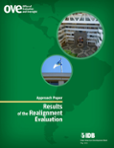Approach Paper: Evaluation of the Results of the Realignment
Date
May 2013
The realignment was proposed to remedy the loss of relevance and presence of the Bank in Latin America and the Caribbean because it had been unable to adapt to: (i) greater access by the countries to alternative sources of financing, (ii) the appearance of new actors, such as subnational governments, responsible for investment decisions, (iii) the heterogeneous nature of the countries of the region, and (iv) pressures to obtain results more quickly. In this context, the Bank was perceived as slow and bureaucratic, with complicated and undifferentiated processes, products that were not very innovative or flexible, and technical capacity and know-how that were lagging behind. The Bank's loss of presence and relevance in the region had a negative impact on its capacity to influence the economic and social development of the region. The reforms associated with the realignment were aimed at sharpening the Bank's country and sector focuses and improving its organizational efficiency and effectiveness. According to the realignment documents, the achievement of those intermediate objectives translates into the attainment of the targets identified. In turn, this greater country and sector focus and organizational efficiency and effectiveness was expected to lead to a greater presence and relevance of the Bank in the region.



